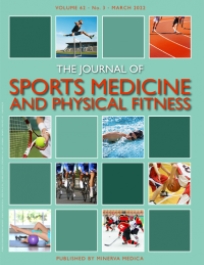Rampinini E1, Connolly DR1, Ferioli D2, La Torre A2, Alberti G2, Bosio A1
1, Human Performance Laboratory, MAPEI Sport Research Centre, Olgiate Olona, Varese, Italy;2, Department of Sport, Nutrition and Health Sciences, Faculty of Exercise Sciences, Università degli Studi di Milano, Italy

AIM: Peripheral fatigue in Knee Extensor (KE) and Plantar Flexor (PF) muscles were investigated following Repeated–Sprint ability (RSA) cycling and running tests. METHODS: Both RSA tests involved 5×6 s sprints and peripheral fatigue was quantified using diverse electrical stimulations (1Hz, 10Hz, 20Hz, 50Hz and 100Hz). RESULTS: RSA cycling induced higher KE decrements in peak torque (PT), maximal rate of torque development and relaxation (PT decrements at different stimulation frequencies: from –39% to –53% cycling vs –16% to –39% running, p < 0.049). The PT ratios of the KE did not highlight differences in low–frequency fatigue. No major differences were noted in PT decrements of PF (p > 0.231); however, greater reductions in some PT ratios (10/100 Hz, 20/50 Hz and 20/100 Hz) confirmed the presence of low–frequency fatigue in PF following RSA cycling. Subjects reported significantly higher RPE leg values following RSA cycling (8.2 vs 7.3 respectively, p = 0.018) despite no differences in blood lactate, hydrogen ions and bicarbonates (p > 0.467). CONCLUSION: Higher levels of peripheral fatigue induced by RSA cycling may be partially related to longer fractional duration of muscle contraction phases that can limit local blood flow. The discrepancies in neuromuscular fatigue between KE and PF can be explained by differences in muscle fibre composition or muscle contributions during RSA tests.
J Sports Med Phys Fitness. Jan-Feb 2016;56(1-2):49-59. Epub 2014 Oct 7. PMID: 25289713